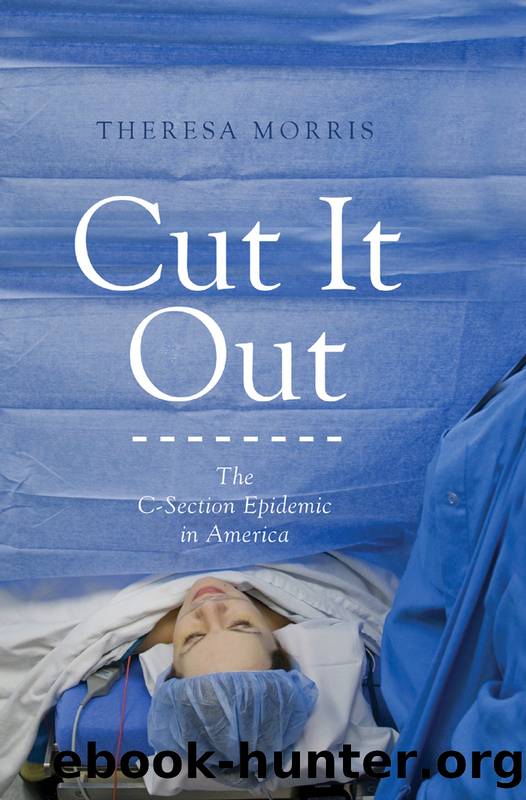Cut It Out by Theresa Morris

Author:Theresa Morris
Language: eng
Format: epub
Publisher: NYU Press
Published: 2013-06-15T00:00:00+00:00
Women Are Commonly Denied VBAC Opportunities
Even with all this evidence of increased risk of repeat c-section, I heard often how ACOG guideline changes caused VBAC efforts to wane. Recall that ACOG largely sets the standard of care, and with the pulling back of ACOG from encouraging VBACs, physicians and hospital administrators began to feel more of a liability threat from bad outcomes in a VBAC attempt. Some hospital administrators, perceiving that hospitals could not meet the more rigorous ACOG guidelines, forbid VBAC attempts in their institutions.56 For example, physicians Jeffry Starling and Jacob Chism tell me:
The American College [ACOG] changed the wording of its recommendation such that only facilities that had [immediately] available anesthesia and [operating rooms] and so forth should be doing trials of labor. [That] definitely had a kind of chilling effect on these trials of labor after cesarean deliveries. ⦠That rate dropped steadily. ⦠So that increased the number of repeat cesarean sections dramatically. (Physician Jeffry Starling)
ACOG went to this immediately available standard that you have to have anesthesia and blood bank facilities immediately available, and a lot of hospitals said, âHey, weâre hearing that VBAC is more risky; weâre going to have to invest all these resources in something that is only going to increase our liability.â So they make an administrative decision that VBAC is not offered at their institution. ⦠Thatâs in the [corporate] suites. ⦠It is a business and liability decision made at the highest levels of the organization. (Physician Jacob Chism)
Doctors Starling and Chism indicate that hospital administrators make decisions to ban VBAC attempts.
In fact, evidence suggests that after ACOG changed the VBAC guidelines in 1999, fewer hospitals offered women the opportunity to attempt a VBAC, and this change was most prominent in rural hospitals, where transfer to another hospital is often difficult due to distance.57 A survey of California hospitals found that a majority of those covered stopped offering VBAC care because they were not able to adhere to ACOG recommendations, particularly the recommendations on staff and resources.58 The International Cesarean Awareness Network, known as ICAN (pronounced I can), is conducting a multiyear project to document hospitals that ban VBAC attempts. ICANâs findings indicate that as of 2012, 30 percent of U.S. hospitals formally ban VBAC attempts.59 As physician Jack Bianco tells me, âThere [are] some hospitals, because of the fear of getting sued over ruptured uteruses with vaginal birth, wonât allow [VBACs] to happen anymore.â
Further, even if hospitals do not ban VBAC attempts, providers may not offer VBAC support, leading to what ICAN refers to as a âde factoâ ban.60 Although the ACOG Bulletin does not provide a definition of what it means for physicians to be âimmediately available,â hospital administrators commonly interpret this language to require physicians to be in the hospital, maybe even on the labor and delivery floor, when a woman attempting a VBAC is in labor.61 That deters some physicians from allowing VBACs for their patients because it ties them to the hospital. They
Download
This site does not store any files on its server. We only index and link to content provided by other sites. Please contact the content providers to delete copyright contents if any and email us, we'll remove relevant links or contents immediately.
When Breath Becomes Air by Paul Kalanithi(7273)
Why We Sleep: Unlocking the Power of Sleep and Dreams by Matthew Walker(5655)
Paper Towns by Green John(4177)
The Immortal Life of Henrietta Lacks by Rebecca Skloot(3833)
The Sports Rules Book by Human Kinetics(3597)
Dynamic Alignment Through Imagery by Eric Franklin(3498)
ACSM's Complete Guide to Fitness & Health by ACSM(3472)
Kaplan MCAT Organic Chemistry Review: Created for MCAT 2015 (Kaplan Test Prep) by Kaplan(3429)
Introduction to Kinesiology by Shirl J. Hoffman(3305)
Livewired by David Eagleman(3133)
The River of Consciousness by Oliver Sacks(2998)
Alchemy and Alchemists by C. J. S. Thompson(2917)
The Death of the Heart by Elizabeth Bowen(2909)
Descartes' Error by Antonio Damasio(2744)
Bad Pharma by Ben Goldacre(2734)
The Gene: An Intimate History by Siddhartha Mukherjee(2500)
Kaplan MCAT Behavioral Sciences Review: Created for MCAT 2015 (Kaplan Test Prep) by Kaplan(2494)
The Fate of Rome: Climate, Disease, and the End of an Empire (The Princeton History of the Ancient World) by Kyle Harper(2442)
The Emperor of All Maladies: A Biography of Cancer by Siddhartha Mukherjee(2437)
